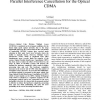Free Online Productivity Tools
i2Speak
i2Symbol
i2OCR
iTex2Img
iWeb2Print
iWeb2Shot
i2Type
iPdf2Split
iPdf2Merge
i2Bopomofo
i2Arabic
i2Style
i2Image
i2PDF
iLatex2Rtf
Sci2ools
JCM
2008
2008
New Receiver Architecture Based on Optical Parallel Interference Cancellation for the Optical CDMA
Optical Code Division Multiple Access (OCDMA) is considered as the strongest candidates for the future high speed optical networks due to the large bandwidth offered by the system, Based on the vast amount of bandwidth, OCDMA systems have received much attention in fiber optic Local Area Networks where the traffic is typically bursty. However, Multiple Access Interference (MAI), which is originated from other simultaneous users, severely limits the capacity of the system. Optical Parallel Interference Cancellation (OPIC) has been used to reduce the effect of MAI. However, the usage of OPIC in OCDMA systems will increase the demand for hardware complexity which results in higher processing time and cost. The hardware complexity increases in the receiver side of OPIC when the number of transmitter (users) increases. To overcome these difficulties, an efficient method is presented in this paper called, One Stage Optical Parallel Interference Cancellation (OS-OPIC) which is based mainly on...
Hardware Complexity | JCM 2008 | Optical Parallel Interference | Parallel Interference Cancellation |
| Added | 13 Dec 2010 |
| Updated | 13 Dec 2010 |
| Type | Journal |
| Year | 2008 |
| Where | JCM |
| Authors | N. Elfadel, A. A. Aziz, E. Idriss, A. Mohammed, N. M. Saad |
Comments (0)

